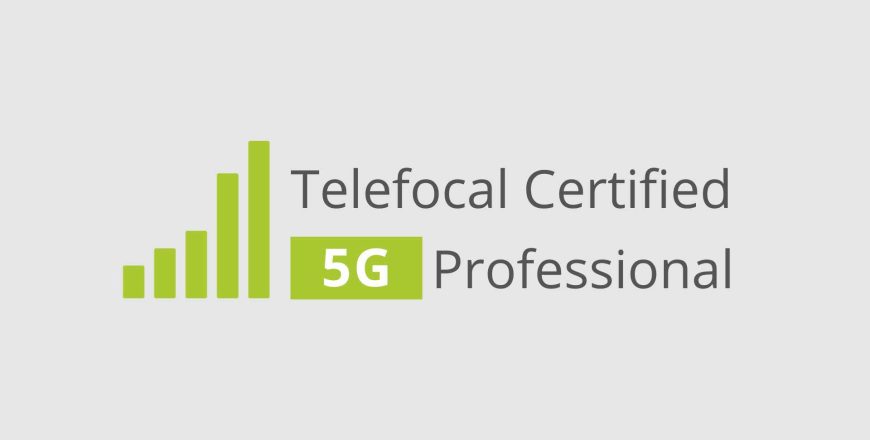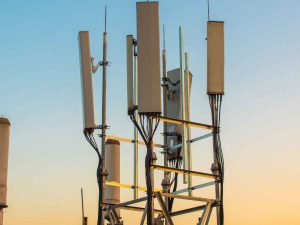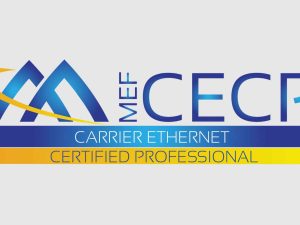Telefocal Certified 5G Professional (TC-5G)

Course Overview
The Telefocal Certified 5G Professional (TC-5G) certification course offers a comprehensive and in-depth exploration of 5G technology, equipping IT and telecom professionals with the knowledge and expertise to excel in the dynamic world of 5G. This course delves into the three key use cases enabled by 5G: enhanced Mobile Broadband (eMBB), Ultra-Reliable Low-Latency Communications (URLLC), and massive Machine-Type Communications (mMTC). Participants will gain a deep understanding of how 5G revolutionizes these use cases, enabling unprecedented levels of connectivity, speed, and reliability.
The course covers a wide range of essential topics, including a thorough overview of the 5G system and its core components, exploring service-based architecture and 5G service exposure. Participants will also delve into emerging technologies like Multi-Access Edge Computing (MEC) and 5G network slicing, which play crucial roles in optimizing performance and meeting diverse application requirements.
The course further addresses vital aspects such as 5G security, IoT and small cells technology enablers, and advanced network planning, empowering professionals to design and implement cutting-edge 5G networks. With a focus on key capabilities in IMT-2020, the course dives into 5G architecture, including core, RAN, and air interface, as well as the NR physical layer, RF design, QoS model principles, small cells planning and design, IoT architecture, and an overview of IoT connectivity methods and technologies.
By completing this certification, participants will be primed to navigate the complexities of 5G networks and make valuable contributions to their organizations’ success in the 5G era.
Target Audience
- Directors, technical managers and team leads responsible for national technology infrastructure planning and regulation
- Senior managers, consultants and engineers in Telecommunications
- Communications and network professionals planning on using, evaluating or working with 5G networks, IoT, small cells, LPWAN etc.
- CSP or IoT product managers who wish to attain a comprehensive understanding of 5G and its capabilities for value creation
- Radio engineers who wish to reskill and understand how 5G packet core works
- Packet core engineers who wish to reskill and understand 5G radio planning
- ICT cyber-security specialists who want a deep dive on 5G cybersecurity
Duration & Training Format
- Classroom: 8 days
- LIVE Virtual*: 56 hours
- A minimum of 6 or more participants are required for a company-based LIVE Virtual course to commence
- LIVE Virtual courses can be conducted for 5 hours or 7 hours daily. Please note that the number of training days will be extended if you opt for 5 hours daily.
Upcoming Course Dates
10 – 19 Feb 2025 (Mon – Following Wed), GMT +08:00
14 – 23 May 2025 (Wed – Following Fri), GMT +08:00
If you are keen on attending the above scheduled courses, please register your interest via our course enquiry form.
Course Objectives
- Design a 5G network with concentration of small cells and IoT solution Integration
- Describe what 5G, small cells, and IoT are, and how they will change the enterprise world
- Explain the ITU 5G standards (IMT2020), along with NGMN alliance and 3GPP
- Identify the top 3 considerations for 5G and IoT cybersecurity
- Describe the features and enhancements of Massive MIMO
- Understand the evolution of 5G and key concepts, drivers, and enablers of 5G
- Explain Service-Based Architecture (SBA), network slicing, SDN, NFV advanced concepts
- Identify threat intelligence for IoT
- Understand the practical aspects of integrating 5G networks with existing 4G and 3G
- Understand the key roles of Wi-Fi 6, 5G in IoT, and the edge era
- Learn how to connect 100 billion human and devices
- Understand New Radio (NR) and Cloud RAN: Cloud- Radio Access Network (C-RAN)
- Understand end-to-end call flows and parameters for optimization
- Design IoT solutions with security and cloud in play
- Understand the 4 stages of IoT architecture
- Learn about advanced small-cell technologies
- Learn how to exploit small cells and 5G for the next cycle of economic growth
Course Outline
- 5G System Overview
- Why 5G
- Architecture of 5G
- Different from LTE
- Changes needed in the RAN and CORE for 5G Deployment
- Master Core Technology
- 5G Design Principles
- Flexibility
- Reliability
- Key differences between 5G and Previous Cellular Technologies
2. 5G System and Core Deep Dive
- Introduction to Service-Based Architecture Model for 5GC
- Introduction to the NG-RAN
- The 5G Core Network Functions
- AMF, SMF, UPF, UDR, UDM, AUSF, NEF, PCF, NSSF, NRF, SEPP, NWDAF
- Interfaces: N1, N4, N5, N6, N7, N8, N9, N10, N11, N12, N13, N14, N15, N35, N36, N37
- Non-Stand Alone (NSA) and Stand-Alone (SA) Options
- 5G Reference Interfaces (Roaming and Non-Roaming)
- Distributed and Flexible Architecture
- Connectivity to Non-3GPP
- User Plane Resources:
- Definition of PDU Session
- Signaling Flow for AF Selection, QoS Session and UE Context Creation
- Service Data Flows
- QoS Flows, Rules, Profiles
- SDF Templates
- Data Radio Bearers and N3 Tunnels
- SMF Control of UPF over N4 Interface
- Policy and Charging Control (PCC)
- Access and Mobility Handling
- QoS / QoE Handling for PDU Sessions
3. Service-Based Architecture (SBA)
- Technical Overview of SDN and SDN Architectures
- Technical Overview of ETSI NFV
- NFV Use Cases
- Service Chaining
- Management and Orchestration
- Telecom Software Architectures and Evolution
- Monolithic, Virtualized, Containerized, Function-Based
- Definitions of Service Based Interfaces
- Network Function (NF)
- NF Service
- Service Producer
- Service Consumer
- NF Registration, Discovery and Selection Procedures
- SBI Protocols
- RESTful APIs
- HTTP, HTTP / 2, JSON
- Zero Touch Service and Network Management
- Cognitive Autonomy
4. 5G Service Exposure
- Mechanisms for External AFs to Control Access and QoS
- Role of Packet Flow Description Function (PFDF)
- User Plane Splitting: Multiple N6 Interfaces for Service-Aware Traffic Steering
- Network Exposure Function (NEF)
- Functionality
- Interactions between 5GC and 3P-NFs
5. Multi-Access Edge Computing (MEC)
- Introduction to MEC
- Definitions
- Background for MEC, Business Drivers and Benefits
- MEC Use Cases
- MEC Standardization
- MEC Technology Enablers
- Microservice-Based Architectures and Beyond
- Cloud-Native Technologies (FaaS, CaaS, VNFs, K8S, HW Accelerators)
- MEC Architecture
- Reference Architecture
- MEC Functions
- Platform, Infrastructure, Applications
- Management Layer
- Edge Services and APIs
- Use Cases
- 5G Apps
- CAPIF, LADN, PDU Session
- IoT Applications
- Challenges and Key Considerations
- Deployment
- Security
- Privacy
6. 5G Network Slicing
- Requirements Grouped by Category
- 5G Radio / Core Network Deployment Scenarios
- Standalone
- Non Standalone
- Comparison of EPC and 5GCN
- NFV as a tool to implement Network slicing
- PFCP vs. OF (OpenFlow)
- Service Function Chaining (SFC)
- Identifiers of Network Slices: NSI ID, NSSAI, S-NSAAI
- GTP Tunnel and PDU Session Types
- Transport Network Slicing – System View
- 3GPP Network Slicing – E2E Service View
- Data-Driven Orchestration
7. 5G Security
- 5G Security Drivers
- Non-Standardized Network Security Measures
- Elements of a 5G Security Architecture
- 5G Security Algorithms
- SDN Security
- NFV Security
- Major 5G Security Issues
- Network Slicing and Network Slice Isolation
- Status in 5G Security Standardization
- Watermark-Based Blind Physical Layer Security (WBPLSec) Model and Application in 5G
- SEAF / ARPF / SEPP
- Authentication Protocols and Key Agreement
- AV Generation: Kausf, XRES, AUTN, RAND
- 5G AKA
- Key Derivation at the AMF
- Device Authentication
- 5G HE AV, 5G SE AV, HXRES*, HRES*, Kseaf
- Security Procedures
- Key Distribution in 5G and Key Hierarchy
- NAS Signalling Security
- RRC Signalling Security
- SUPI and SUCI
- Multiple Registrations
- Securing AN to CN Communications
- IPSec Basic Operation and IPSec ESP
- Establishment of gNB Security Association
- X.501 Certificate Exchange
- Inter Operator Network Security
- SBA: Risks, Threats and Recommendations
- Cloud and Virtualization Security
- C-RAN Security
- 5G IoT Security
- MEC / Distributed Cloud Security
- Safety of 5G Network Physical Infrastructures
- 5G Customer Edge Switching Security
- 5G Positioning and Privacy
- Securing 5G Automation
- Software Defined Security Monitoring in 5G
- 5G Monitoring and Security Operations
- Implementing and Auditing 5G Security Controls
- 5G Forensics and Analysis
- 5G Cybersecurity Risk Management and Recommendations
8. 5G, IoT and Small Cells Technology Enablers
- Dynamic Spectrum Access (DSA)
- Interference Management
- Small Cells
- Coordinated Multipoint
- Mass-Scale MIMO, Massive MIMO
- Personal Mobile Internet
- Software-Defined Radio (SDR)
- Cognitive Radio
- Smart-radio
- Multi-Hop Networks
- Direct Device-to-Device (D2D) Communications
- Dynamic Adhoc Wireless Networks (DAWN)
- IPv6 and 6LowPAN
- Centralized RAN vs. Cloud RAN
- NFV, SDN, and Cloud Networking
- Massive Machine Communication (MMC)
- Massive Internet of Things (IoT)
- Moving Networks (MN)
- Ultra-Dense Networks (UDN)
- Ultra-Reliable Communication (URC)
- Mobile Ad Hoc Network (MANET)
- Wireless Mesh Network (WMN)
- Vandermonde-Subspace Frequency Division Multiplexing (VFDM)
- Millimeter-Wave (mmWave)
- 5G Cloud Radio Access Network (C-RAN)
- Ultra Small Cells-Based Heterogeneous Network (HetNet)
- Heterogeneous Cloud Radio Access Network (H-CRAN)
- Ultra Reliable and Low Latency Communication (URLLC)
- Full Dimension MIMO
- Adaptive Coding and Modulation (AMC)
- Filter-Bank Multi-Carrier (FBMC)
- Frequency and Quadrature Amplitude Modulation (FQAM)
9. How to Plan an Advanced 5G Network
- Increasing Wireless Capacity by 1000 Times
- Connecting 20 Billion People-Oriented Devices
- Connecting 1 Trillion Objects in the Internet of Things
- Saving 90% of the Energy Used
- Supporting Ten-Year Battery Life for Low Power IoT-Type Devices
- Providing Latency of Under 5 Milliseconds (ms)
- Providing a Perceived Connection Reliability of 99.999%
- Reducing Time Required to Create a Network Device from 90 Hours to 90 Minutes
10. Key Capabilities in IMT-2020
- Peak Data Rate
- Latency
- Mobility
- Connection Density
- Energy Efficiency
- Energy Efficiency Aspects:
- Spectrum Efficiency
- Area Traffic Capacity
11. 5G Architecture – CORE
- Service-Based Architecture
- From Network Function to Network Function Service
- Cloud Adoption
- Network Slicing
- Slice Management and Orchestration
- gNB and ng-eNB Functionalities
- 5G Core Architecture – Network Functions:
- AMF Functionalities
- AMF Functionalities
- UPF Functionalities
- SMF Functionalities
- 5G Network Interfaces
- Network Slice Selection Function
- Network Exposure Function – External Exposure
- Network Exposure Function – Internal Exposure
- Network Repository Function
- Unified Data Management
- Unified Data Repository
- Policy Control Function
- Authentication Server Function
- NG Interface
- Xn Interface
- Control Plane
- User Plane
- 5G Radio Protocol Architecture
- Multi-RAT Dual Connectivity
- Comparing LTE and 5G Core
12. 5G Architecture – RAN and Air Interface
- 5G / NR RAN Architecture
- Functional Split between NG-RAN and 5GC
- 5G Radio Architecture Options for Cloud RAN gNB
- Functional Split in the gNB
- 5G Advancement and Air Interface
- 5G Spectrum Outlook
- Radio Parameter Comparison – LTE and NR
- 5G NR – The New Radio Interface for 5G
- Scalable OFDM
- Advanced LDPC Channel Coding
- Ultra-Reliable Low-Latency Communication (URLLC)
- 5G NR – The New Radio Interface for 5G
- Beamforming in mm-Wave (30 GHz to 300 GHz)
- Massive MIMO and Beamforming
13. 5G NR Physical Layer
- 3GPP 5G NR Physical Layer Specs
- 5G Frame Structure Enhancements
- LTE Frame Structure
- LTE Generic Frame Structure
- LTE DL Physical Layer Parameters
- 5G Frame Structure – Resource Grid
- Numerology – Subcarrier Spacing
- Numerology and Slot Length
- 5G Frame Structure – Scalable NR Slot Duration
- 5G Channel Structure
- Logical Channels
- Transport Channels
- Physical Channels and Signals
- 5G Channel Structure vs. LTE
- DL Channels and SS / PBCH Block
- UL Channels and Signals
14. 5G Protocols
- UE-5GC Control Plane Protocol Stack
- UE-5GC User Plane Protocol Stack
- 5G NR-RAN Control Plane Protocol Stack
- 5G NR-RAN User Plane Protocol Stack
- 5G-NR Layer 3 (RRC) Functions
- 5G-NR Layer 2 Function
15. 5G RF Design
- 5G Propagation Models
- 5G Indoor and Outdoor Small Cell Design
- 5G Propagation Model Equations and Formulas
- RF Design Inputs
- RF DL Link Budget
- RF UL Link Budget
- Traffic Mapping
- RF Planning Tools
- Traffic Modelling
- RF Prediction
- Analysis and Reiteration of the Result
16. 5GS QoS Model Principles
- 3GPP QoS Specifications
- 5G System QoS Model
- QoS Flow
- QoS Flow ID
- 5GS QoS Parameters and Characteristics
- 5GS QoS Flow Handling
- DL QoS Flow Handling
- UL QoS Flow Handling
- Service Data Adaptation Protocol
- QoS Characteristics:
- Resource Type
- Priority Level
- Packet Delay Budget
- Packet Error Rate
- Averaging Window
- Maximum Data Burst Volume
17. Small Cells Planning and Design
- Market Drivers for Data Capacity, Coverage and Quality
- Small Cells Basics
- Small Cells Architecture
- Device to Device (D2D)
- Radio Technology Evolution
- Residential Small Cells
- Enterprise Small Cells
- Metrocells / Urban / Public Access / Rural
- Small Cells
- Small Cell Gateways
- Wireless Backhaul
- Planning and Operational Management
- Wi-Fi and Small Cells
- Commercial Deployment
18. IoT Architecture
19. Overview of IoT Connectivity Methods and Technologies
- ZigBee PRO, ZigBee 3.0 and ZigBee IP
- 6LowPAN
- RFID
- Bluetooth LE or Bluetooth Smart Technology
- Z-Wave
- IEEE 802.15.4, IEEE 802.15.4e, 802.11ah
- 802.11ah, Wi-Fi HaLow
- GSM, CDMA, GPRS,3G, LTE, small cells, SATCOM
- Sensors and Sensor Networks
- MIPI, M-PHY, UniPro, SPMI, BIF, SuperSpeed USB Inter-Chip (SSIC), Mobile PCIe (M-PCIe) and SPI
- Wired Connectivity
- IPv4 / IPv6
Certification: At the end of the course, participants will sit through a written examination. A professional certificate will only be issued upon:
- Scoring 60% or higher in the written exam AND
- Achieving at least 75% attendance for the course.
Pre-requisites
Participants are advised to have some prior knowledge on the following:
- 2G, 3G or 4G technologies
- IP networking
- Software/Web technologies and principles e.g. API, HTTP, etc.
- Cloud technologies e.g. Virtualization, Containers, DevOps etc.
- Radio principles e.g. Radio propagation, how antennas work, and wireless connectivity basics like IoT, Small Cells, WiFi concepts.
- Basic understanding of cybersecurity and protocols e.g. ciphers, public keys, HTTPS, TLS.
What is so special about Telefocal's 5G Certification programme?
Telefocal’s 5G certification course contents are developed by our trainers who are 5G creators and subject matter experts who work daily on 5G technology creation, deployment and design. We are vendor-neutral, and our 5G course covers standards from various industry standards organisations, such as ITU, ETSI, 3GPP, IETF, ONF, TMF and MEF. These course contents are designed and tailored to be compliant to relevant industry standards for 5G.
Telefocal’s 5G certification course aims to impart the required knowledge and expertise, and helps elevate your proficiency in the 5G subject matter. It seeks to validate your professional knowledge and skills in 5G, and assist you to engage in professional practices and gain industry recognition. As a TC-5G professional, you would project confidence in others to engage your service in the 5G domain.
Candidates would undergo a proctored examination at the end of the rigorous training. Candidates who pass the 5G certification exams will be certified as a TC-5G professional.
Be the first to add a review.
Related Courses




